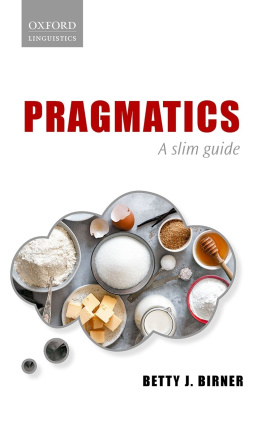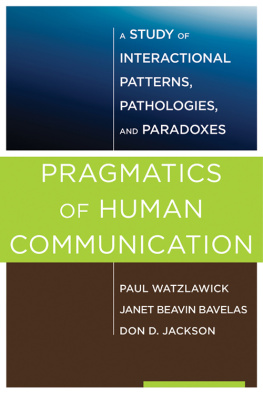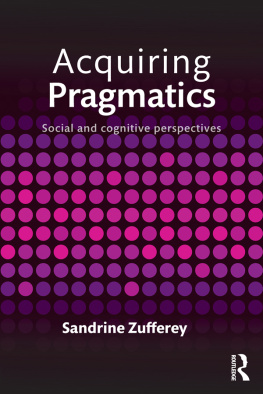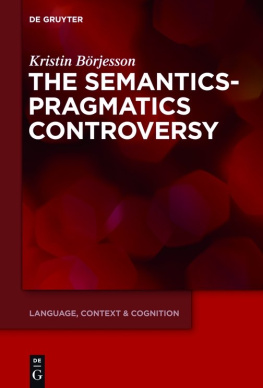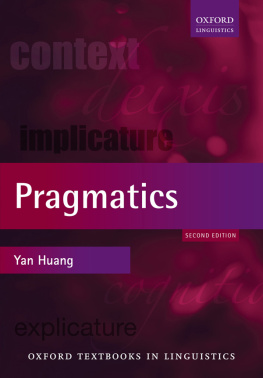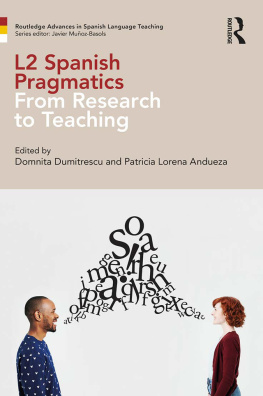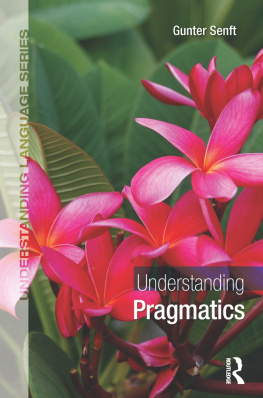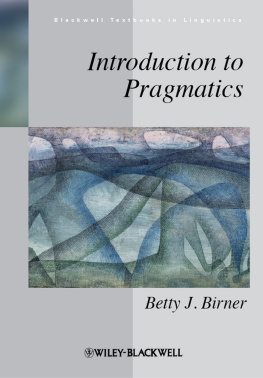PRAGMATICS
MODERN LINGUISTICS SERIES
Series Editor
Professor Maggie Tallerman
University of Newcastle
Each textbook in the Modern Linguistics series is designed to provide a carefully graded introduction to a topic in contemporary linguistics and allied disciplines, presented in a manner that is accessible and attractive to readers with no previous experience of the topic but leading them to some understanding of current issues. The texts are designed to engage the active participation of the reader, favouring a problem-solving approach, and including liberal and varied exercise material.
Titles published in the series
English Syntax and Argumentation (3rd edition) Bas Aarts
Phonology Philip Carr
Pragmatics Siobhan Chapman
Linguistics and Second Language Acquisition Vivian Cook
Sociolinguistics: A Reader and Coursebook Nikolas Coupland and Adam Jaworski
Morphology (2nd edition) Francis Katamba and John Stonham
Semantics (2nd edition) Kate Kearns
Syntactic Theory (2nd edition) Geoffrey Poole
Contact Languages: Pidgins and Creoles Mark Sebba
Further titles in preparation
Modern Linguistics Series
Series Standing Order
ISBN 0333717015 hardback
ISBN 0333693442 paperback
(outside North America only)
You can receive future titles in this series as they are published by placing a standing order. Please contact your bookseller or, in the case of difficulty, write to us at the address below with your name and address, the title of the series and one of the ISBNs quoted above.
Customer Services Department, Palgrave Ltd
Houndmills, Basingstoke, Hampshire RG21 6XS, England, UK
Pragmatics
Siobhan Chapman


Siobhan Chapman 2011
All rights reserved. No reproduction, copy or transmission of this publication may be made without written permission.
No portion of this publication may be reproduced, copied or transmitted save with written permission or in accordance with the provisions of the Copyright, Designs and Patents Act 1988, or under the terms of any licence permitting limited copying issued by the Copyright Licensing Agency, Saffron House, 6-10 Kirby Street, London EC1N 8TS.
Any person who does any unauthorized act in relation to this publication may be liable to criminal prosecution and civil claims for damages.
The author has asserted her right to be identified as the author of this work in accordance with the Copyright, Designs and Patents Act 1988.
First published 2011 by
PALGRAVE MACMILLAN
Palgrave Macmillan in the UK is an imprint of Macmillan Publishers Limited, registered in England, company number 785998, of Houndmills, Basingstoke, Hampshire RG21 6XS.
Palgrave Macmillan in the US is a division of St Martins Press LLC, 175 Fifth Avenue, New York, NY 10010.
Palgrave Macmillan is the global academic imprint of the above companies and has companies and representatives throughout the world.
Palgrave and Macmillan are registered trademarks in the United States, the United Kingdom, Europe and other countries.
ISBN 9780230221826 hardback
ISBN 9780230221833 paperback
This book is printed on paper suitable for recycling and made from fully managed and sustained forest sources. Logging, pulping and manufacturing processes are expected to conform to the environmental regulations of the country of origin.
A catalogue record for this book is available from the British Library.
A catalog record for this book is available from the Library of Congress.
10 9 8 7 6 5 4 3 2 1
20 19 18 17 16 15 14 13 12 11
Printed and bound in Great Britain by MPG Books Group, Bodmin and Kings Lynn
Preface
Pragmatics is an exciting and fast moving field of present day linguistics. The aims of this book are to describe both early and recent developments in pragmatics, and also to show how pragmatics relates to the study of language more generally. It is suitable for those who are just starting out in pragmatics, since it assumes no previous knowledge of the subject. However, it does more than provide an introductory overview; it encourages the reader to engage with some of the fundamental issues faced by pragmaticists, and to appreciate the current controversies and debates in which they are engaged. It is therefore aimed primarily at students taking undergraduate degree level courses in pragmatics or in linguistics more generally, but it should also be of use to postgraduate students in these areas and to researchers in linguistics and related disciplines who want to find out about what is currently going on in pragmatics.
The focal part of this book is the two large , which set out the main theories, terminologies and mechanisms of pragmatics. It is therefore these two chapters that conclude with suggested exercises and discussion questions, designed to help readers practise their understanding of the content of the chapters and also consider the wider implications of the different theories discussed. The other chapters put the central theories of pragmatics in context. The early chapters explain something of the nature of pragmatics, including the types of data it is centrally concerned with and its relatively recent emergence as a field of inquiry in its own right. The later chapters extend the scope of the discussion by considering how pragmatic theories have interacted with, and had an impact on, the study of a wide range of phenomena relating to language use.
Like most specialist fields of inquiry, pragmatics has developed a range of technical terms that can prove daunting to those new to the discussion. For this reason, this book concludes with a glossary of some of the main technical terms that readers will encounter, to provide a quick point of reference. Those terms that are included in the glossary are printed in SMALL CAPITALS when they first appear in the main text.
It has become standard practice in pragmatics to use the pronoun she to refer to the speaker of any utterance under discussion, and he to refer to the hearer, and this is a practice that will be adopted in this book. It avoids the stylistic or grammatical awkwardness of using either he or she or they on each occasion. Since one of the things we learn from pragmatics is that both speaker and hearer have a vital and active part to play in the collaborative creation of meaning in context, it privileges neither the female nor the male protagonist.
I am grateful to Kitty Van Boxel and the editorial team at Palgrave Macmillan for their encouragement, enthusiasm and patience during the writing of this book, and to my family for putting up with my even more gloomy than usual predictions about whether it would ever be finished. Maggie Tallerman and two anonymous reviewers made very helpful comments and suggestions on the first draft, for which I am very grateful. I am also grateful to the students who took my second year Pragmatics module at the University of Liverpool during the academic year 200910, for serving as unwitting guinea pigs for the material presented here, and for keeping smiling through all the pragmatic theory that I could throw at them.
SIOBHAN CHAPMAN
Introduction
Some statements about pragmatics are easy to make and are not likely to prove too controversial. Pragmatics is one component of the study of human language, and can therefore be described as a branch of the academic discipline of linguistics. It has emerged relatively recently, certainly within the last half century, but is now an important and thriving area that continues to expand and develop. Concepts, theories and approaches developed within pragmatics are being used by those working in many other areas: both in other branches of linguistics, such as sociolinguistics, stylistics and psycholinguistics, and in different disciplines, such as artificial intelligence, clinical psychology and even law.
Next page



